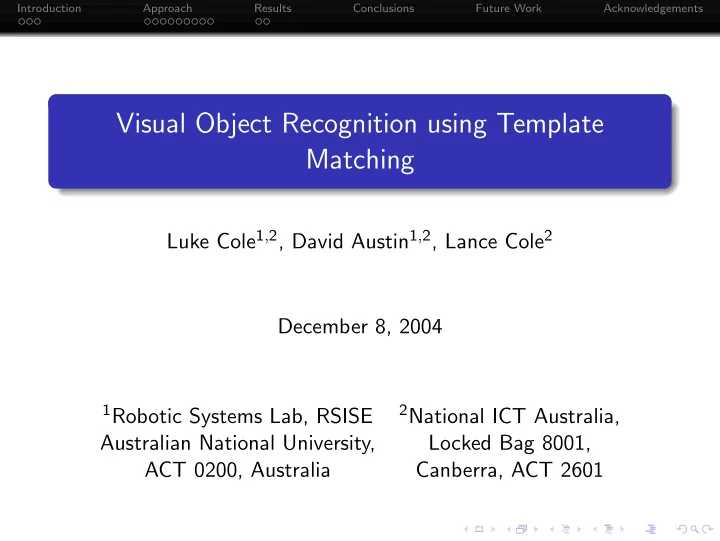

Introduction Approach Results Conclusions Future Work Acknowledgements Visual Object Recognition using Template Matching Luke Cole 1 , 2 , David Austin 1 , 2 , Lance Cole 2 December 8, 2004 1 Robotic Systems Lab, RSISE 2 National ICT Australia, Australian National University, Locked Bag 8001, ACT 0200, Australia Canberra, ACT 2601
Introduction Approach Results Conclusions Future Work Acknowledgements Quick Overview of Template Matching This is an old well established technique. A simple task of performing a correlation between a template image (object in training set) and a new image to classify. Sum of All Differences (SAD) Sum of Square Differences (SSD) Normalised Cross Correlation (NCC) Below: Raw Template (left), Edge Based Template (right). For each image set: test image (left), template (right).
Introduction Approach Results Conclusions Future Work Acknowledgements The Research Template Matching is a rich object detector. Captures entire essence of an object (not the case for many “higher-order” techniques). Some object have no or poor internal features so they are not well suited to “higher order” techniques. E.g. aspect graphs use edge features. It’s not always possible/easy to detect edges. So what is the problem with Template Matching? It’s expensive! This research addresses this scaling problem with results based on 91 classes and 140 000 extracted blobs each of size 680x480. Biologically inspired for real time long-term visual robotic systems.
Introduction Approach Results Conclusions Future Work Acknowledgements Not always easy to detect edges
Introduction Approach Results Conclusions Future Work Acknowledgements Approach Introduction Training database acquisition and extraction. Training database reduction to create template images. Random classification via NCC’s as it is the best form of correlation and the most expensive.
Introduction Approach Results Conclusions Future Work Acknowledgements The Object Database Lego Bricks 140 000 image with 91 bricks, approximately 1000 different views for each class. Why is it a good database?
Introduction Approach Results Conclusions Future Work Acknowledgements Training Database Acquisition
Introduction Approach Results Conclusions Future Work Acknowledgements Training Database Acquisition
Introduction Approach Results Conclusions Future Work Acknowledgements Training Database Acquisition
Introduction Approach Results Conclusions Future Work Acknowledgements Training Database Extraction
Introduction Approach Results Conclusions Future Work Acknowledgements Training Database Reduction Classifying a new test image across all the extracted blobs would be computationally infeasible. So we reduce the set (since we expect similar and incorrect images). If two images are similar, we do not simply keep one image and remove the rest. Instead, a clustering approach was taken. Each class is represented by a two-tier hierarchical structure.
Introduction Approach Results Conclusions Future Work Acknowledgements Training Database Reduction
Introduction Approach Results Conclusions Future Work Acknowledgements Training Database Reduction Obviously determining the correct NCC threshold would be a task in itself. So our results are based on four reduced sets with the NCC threshold equal to 0.75, 0.8, 0.85, 0.9.
Introduction Approach Results Conclusions Future Work Acknowledgements Recognition Procedure
Introduction Approach Results Conclusions Future Work Acknowledgements Results C/C++ Implementation. Images obtained from a standard webcam (640x480). Results obtained on a AMD Athon(tm) XP 2700+ with 1GB of memory, running Debian Linux. Different reduced sets ( M ) and closest classes ( n avg ).
Introduction Approach Results Conclusions Future Work Acknowledgements Accuracy and Execution Time 100 25 Accuracy (using colour hack) (%) 80 20 Execution time (sec) 60 15 40 10 20 M = 0.75 5 M = 0.75 M = 0.8 M = 0.8 M = 0.85 M = 0.85 M = 0.9 M = 0.9 0 0 3 5 10 15 20 3 5 10 15 20 Closest classes n_{avg} Closest classes n_{avg} Lastest result: 90% in 6.75 seconds for n avg = 15, M = 0 . 9
Introduction Approach Results Conclusions Future Work Acknowledgements Reduced and Examined Images 4000 Number of Images examined per classification M = 0.75 25000 M = 0.8 3500 M = 0.85 M = 0.9 20000 3000 Number of Images 2500 15000 2000 10000 1500 1000 5000 500 0 0 0.75 0.8 0.85 0.9 3 5 10 15 20 M Closest classes n_{avg}
Introduction Approach Results Conclusions Future Work Acknowledgements Conclusions Uses all of the information about each object Not exactly real-time, however still favorably over more complex methods that take many minutes (NCC optimizations). Clustering and averaging seems an interesting way to catalogue and classify an object. Large computation required for unsegmented recognition
Introduction Approach Results Conclusions Future Work Acknowledgements Future Work More rigorous method to extracting and clustering. The green factor! Hardware implemention to template matching (FPGA). More camera views. Physical interaction.
Introduction Approach Results Conclusions Future Work Acknowledgements Acknowledgements This work was supported by funding from National ICT Australia. National ICT Australia is funded by the Australian Government’s Department of Communications, Information Technology and the Arts and the Australian Research Council through Backing Australia’s Ability and the ICT Centre of Excellence program.
Recommend
More recommend